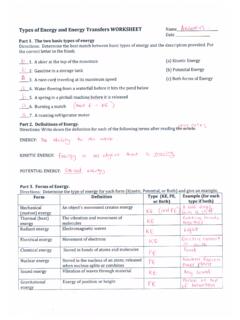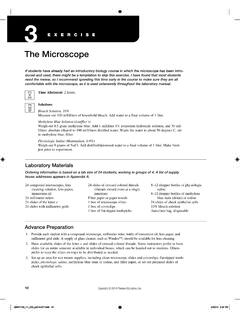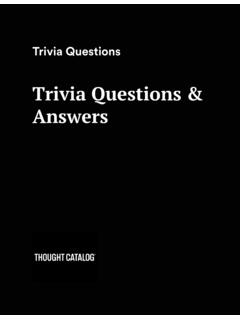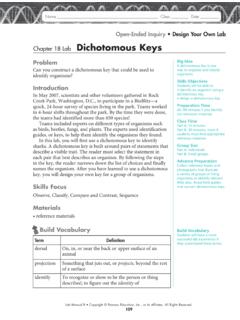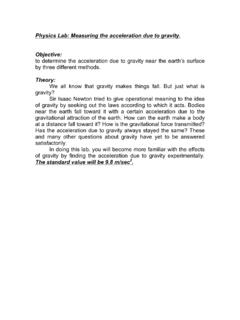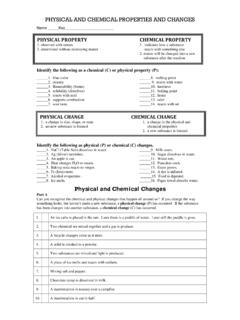Transcription of Karen Mayes - Mrs. Smith's World of Science
1 Karen Mayes Page 1 of 3 DNA Paper Model Activity Level: Grade 6-8 Students will be able to: 1. Identify the component molecules of DNA. 2. Construct a model of the DNA double-helix. 3. Identify which bases are found in pairs in the DNA double-helix. 4. Predict the appearance of a complimentary strand of DNA when given half of a double-helix molecule. NOTE: This lesson can be split into two days for more "Cut and Paste" time if a longer DNA molecule is desired. Vocabulary: Adenine, Guanine, Cytosine, Thymine, Deoxyribose Sugar, Phosphate, Double-Helix, Nitrogen Base, Eukaryotic, Prokaryotic.
2 Materials: Reproducible pictures of DNA components on multi-colored paper, scissors, glue sticks or tape. Pacing: 50 minutes State Standards , , , 1. Wisconsin State Standards: Targeted Resources Use models and explanations to predict actions and events in the natural World Understand the structure and function of cells, organs, tissues, organ systems, and whole organisms; Investigate and explain that heredity is comprised of the characteristic traits found in genes within the cell of an organism; Show how different structures both reproduce and pass on characteristics of their group. 2. Notes for the teacher: Targeted Resources This lesson adapted from the MCPS Biology Curriculum, found online at: Advanced Preparation: Make transparencies of the Lessons Learned and Half a Helix sheets.
3 Make copies of the student procedure and homework sheet, one per student. The final molecule must be 'color coded' for the greatest effect. Remember it will be a useful tool for the rest of the year. Copy the template diagrams to colored paper for lab groups (put each template on a separate color.) For a speedy assembly, give each student 4 bases, 4 sugars, and 4 phosphates. Alternately, for a longer strand and a more team-based approach, give DNA Model Templates Karen Mayes Page 2 of 3 each team 10 of each base, 40 sugars, and 40 phosphates. This method takes more time, but cements concepts more firmly, as students aren t likely to forget the parts of DNA when they ve spent an hour cutting the tiny pieces out!
4 Other notes: Have every lab group connect their DNA strands together by taping them. Use Scotch tape. The term nucleotide does not appear in the introduction. As written, this is a research extension that should be discovered after the entire molecule has been constructed. 3. ANTICIPATORY SET (10 minutes) Targeted Resources Review with students what they already know about DNA and introduce new concepts through questioning. NOTE: Asking students to answer questions about topics they may not have yet read about prompts them to make predictions or educated guesses, which is a valuable Science skill. Ask: What is DNA? (The genetic blueprint molecule of living things.)
5 Ask: What is a eukaryotic cell? (A cell with a nucleus, found in animals and plants) Ask: What is a prokaryotic cell? (A cell with no nucleus, found in bacteria) Ask: Where do we find DNA? (In the nucleus of eukaryotic cells or in the cytoplasm of prokaryotic cells) Ask: What shape is the DNA molecule? (A twisted ladder or double-helix) Ask: What is DNA made of? (A phosphate backbone supporting rungs of deoxyribose sugars and nitrogen base pairs.) Ask: What are the four nitrogen bases? (Adenine, Thymine, Guanine, Cytosine) Ask: Which bases always pair-up in the DNA molecule? (A-T, G-C) 4. PURPOSE AND INPUT (5 minutes) Targeted Resources Put "Lessons Learned" transparency on the overhead.
6 This shows students why they are completing this activity. (This transparency simply states the lesson objectives and vocabulary.) Leave the transparency up through the class so students can check them off as they achieve understanding of each objective or term. DNA Model Lessons Learned Check 5. MODELING (5 minutes) Targeted Resources Hand out instruction sheets. Explain that students will be given a set of paper DNA components. They will be cutting these components out and assembling them together (in small groups) to form a DNA strand. Show the components of 1 "unit" of the DNA polymer. Assemble them using tape, demonstrating how one rung of the double-helix goes together.
7 DNA Model Student Procedure Karen Mayes Page 3 of 3 Point out the markings on the templates, showing how the molecules are assembled by matching like symbols. Stress the importance of laying all components out BEFORE gluing or taping it together. (Otherwise, the molecule tends to shift, shrink, or otherwise become distorted.) 6. GUIDED PRACTICE (20 minutes) Targeted Resources Students will assemble the DNA molecules. This can be done in groups of 3-4 students. Have each group assemble a number of DNA rungs equal to twice the number of students in the group. (Therefore, a group of 4 would make 8 rungs.) Stress that the bases must be paired correctly, but that the rungs can be assembled in any order.
8 When all groups have assembled their strand of DNA, put them together to form one long class strand. 7. CHECKING FOR UNDERSTANDING (5 minutes) Targeted Resources When the class model is assembled, go down the list of objective questions and ask them to the group. Be sure to emphasize any areas where there might be confusion. 8. INDEPENDENT PRACTICE Targeted Resources Hand out take-home worksheet. This sheet prompts students to synthesize and expand the skills they've learned, relating the structure of DNA to its function in the cell. DNA Paper Model Homework Sheet 9. CLOSURE (5 minutes) Targeted Resources Quickly review the components of DNA: 1) Bases 2) Deoxyribose sugar molecules 3) Phosphate molecules Put up the "Half-a-helix" transparency on the overhead.
9 Go around the room (one student at a time) and have them tell which base would be added to the other half of the DNA molecule to complete the strand. Half-A-Helix LESSONS LEARNED: Can I identify the components of a DNA molecule? Can I construct a model of the DNA double-helix using paper templates of those components? Can I identify the four bases in the DNA double-helix and explain which bases pair together? Could I predict what the second half of a DNA strand would look like if I was given one side of the double-helix as a template? Can I define the following terms? Adenine Guanine Cytosine Thymine Deoxyribose Sugar Phosphate Double-Helix Nitrogen Base Eukaryotic Prokaryotic Name: _____ DNA PAPER MODELS PROCEDURE Introduction: Imagine DNA as a twisted ladder.
10 The outside of the ladder is made up of alternating sugar and phosphate molecules. The sugar is called deoxyribose. The rungs of the ladder are made of a pair of molecules called bases. There are four bases in DNA: adenine, guanine, cytosine, and thymine. Because of the chemical structures of the bases, adenine only pairs with thymine and cytosine only pairs with guanine to form a rung. Procedure: 1. From the paper provided by your teacher, cut out the pattern for the chemical bases sugars, and phosphates assigned to you. 2. Arrange the cut outs on your lab table to form the pattern described in the introduction. BE SURE YOU LAY ALL PIECES OUT BEFORE GLUING THEM TOGETHER!
